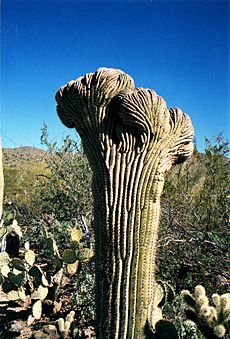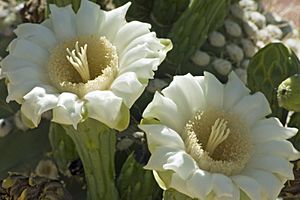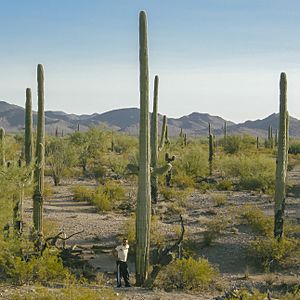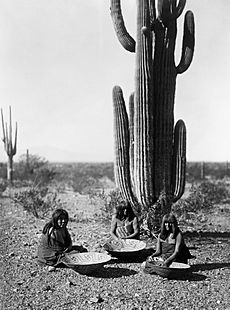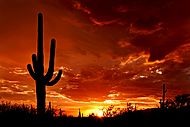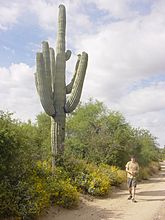Saguaro facts for kids
The saguaro (Carnegiea gigantea) is a very tall, tree-like cactus. It can grow to be over 12 meters (40 feet) tall! This amazing plant is found naturally in the Sonoran Desert, which stretches across Arizona in the United States and Sonora in Mexico. You can also find a few saguaros in parts of California. The beautiful saguaro blossom is the official state wildflower of Arizona. The saguaro's scientific name, Carnegiea, honors a famous person named Andrew Carnegie. To help protect these special cacti and their homes, Saguaro National Park was created near Tucson, Arizona in 1994.
Quick facts for kids Saguaro |
|
|---|---|
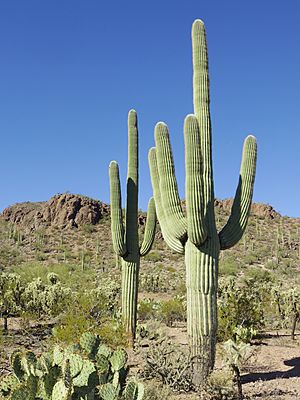 |
|
| Conservation status | |
| Scientific classification | |
| Genus: |
Carnegiea
|
| Species: |
gigantea
|
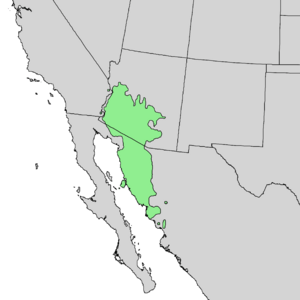 |
|
| Natural range of Carnegiea gigantea | |
| Synonyms | |
|
|
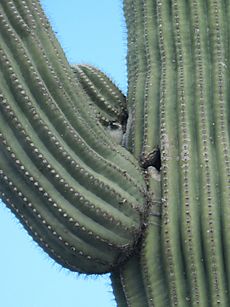
Saguaros live a long time, often more than 150 years. They might grow their first side arm when they are about 75 to 100 years old. Some saguaros never grow any arms at all. The arms help the plant make more flowers and fruit, which means more seeds for new saguaros.
A saguaro can soak up and store a lot of rainwater. You can even see it expand when it's full of water! It slowly uses this stored water when it's dry. This helps the saguaro survive long periods without rain. The saguaro cactus is a well-known symbol in Mexican culture and in movies about the American Southwest.
Contents
What is a Saguaro?
The saguaro is a tall, column-shaped cactus that grows noticeable branches, often called arms. One plant can grow as many as 49 arms! Saguaros usually grow from 3 to 16 meters (10 to 52 feet) tall. They can be up to 75 centimeters (30 inches) wide. They grow slowly but often live for 150 to 200 years. They are the biggest cacti in the United States.
How fast a saguaro grows depends a lot on how much rain it gets. Saguaros in drier parts of western Arizona grow only half as fast as those near Tucson. Young saguaros grow slowly from seeds. They might only be 6 millimeters (1/4 inch) tall after two years.
The largest known living saguaro in the United States is in Maricopa County, Arizona. It is 13.8 meters (45 feet 3 inches) high and 3.1 meters (10 feet 2 inches) around. Experts think it is about 200 years old. The tallest saguaro ever measured was near Cave Creek, Arizona. It had no arms and was 23.8 meters (78 feet) tall before a windstorm knocked it down in 1986.
Saguaros are stem succulents, meaning their stems store water. When there's a lot of rain and a saguaro is full of water, it can weigh between 1,450 and 2,180 kilograms (3,200 and 4,800 pounds).
| Height | Age (Years) |
|---|---|
| 0.5 feet (0.15 m) | 9 |
| 1.0 foot (0.30 m) | 13 |
| 5.0 feet (1.5 m) | 27 |
| 10.0 feet (3.0 m) | 41 |
| 20.0 feet (6.1 m) | 83 |
| 25.0 feet (7.6 m) | 107 |
| 30.0 feet (9.1 m) | 131 |
| 35.0 feet (10.7 m) | 157 |
Saguaros have a very large network of roots that can spread out up to 30 meters (98 feet). They also have long taproots that go down about 1 meter (3 feet 3 inches) deep.
It can take a saguaro between 20 and 50 years to reach a height of 1 meter (3 feet 3 inches).
As a cactus, the saguaro has a special way of making food called crassulacean acid metabolism photosynthesis. This helps it use water very efficiently. It only "breathes" out water at night, which means it loses less water during the hot day.
A saguaro without any arms is sometimes called a "spear."
Some saguaros grow in rare shapes called a cristate, or "crested" saguaro. This unusual growth is thought to happen in about 1 out of every 10,000 saguaros. The crest forms a wavy line of growth along the top of the saguaro or its arm.
Saguaro Ribs
Inside the saguaro, there are many "ribs" made of wood. These ribs are like a skeleton for the cactus. Each rib can be as long as the cactus itself and a few centimeters wide. The wood from these ribs is quite strong. Native peoples used the dry ribs as building material. Even after a saguaro dies, its ribs are important for keeping the desert soil healthy.
Saguaro Spines
The spines on a saguaro are very sharp. They can grow up to 7 centimeters (2 3/4 inches) long. A spine can grow about 1 millimeter (1/32 inch) per day. When you look closely, you can see light and dark bands on the spines. These bands show how much the spine grew each day.
Saguaro spines can cause serious injuries to animals and humans. They are as sharp and strong as steel needles. If a spine breaks off inside your skin, it can be hard to remove. However, these injuries usually don't get infected because cactus spines are generally clean.
Reproduction
Saguaro Flowers
The saguaro's white, waxy flowers bloom from April to June. They open after sunset and close in the middle of the next afternoon. They keep making sweet nectar even after the sun comes up. Saguaro flowers need pollen from another saguaro to make seeds. They produce a lot of pollen because each flower has many tiny seeds inside. One flower can have thousands of pollen-making parts!
Many different animals help pollinate saguaro flowers. The main helpers are honey bees, bats, and white-winged doves. Honey bees are the biggest helpers during the day. Other daytime pollinators include hummingbirds and other birds like orioles and woodpeckers.
The main pollinator at night is the lesser long-nosed bat. These bats drink the nectar. Saguaro flowers have special features that attract bats: they open at night, their pollen is ready at night, they have lots of rich nectar, they grow high up, they are strong enough for a bat's weight, and they smell good at night.
The flowers are about 8.6 to 12.4 centimeters (3.4 to 4.9 inches) long and stay open for less than 24 hours. Since flowers only grow at the top of the plant and the tips of its branches, having many branches helps the saguaro make more seeds. Flowers open one after another, with about four flowers open each day during the month-long blooming season.
Saguaro Fruit
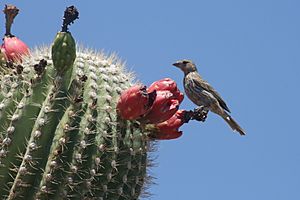
The saguaro's ruby-red fruits are 6 to 9 centimeters (2 1/2 to 3 1/2 inches) long. They ripen in June. Each fruit holds about 2,000 tiny seeds, surrounded by sweet, juicy flesh.
The fruits are often too high to reach by hand. People use a long pole, sometimes made from saguaro ribs, to hook the fruits or knock them down. These poles can be 4.5 to 9 meters (15 to 30 feet) long.
Saguaro seeds are small and don't last long. Even though they sprout easily, most seeds don't grow into new plants because animals eat them or there isn't enough water. Seeds need to wait 12 to 14 months before they can sprout. Not enough water during this time greatly reduces their chances of survival.
Young saguaros need "nurse plants" to grow. Trees like palo verde and triangle bursage act as nurse plants. They help by keeping the temperature from getting too hot or too cold, adding nutrients to the soil, and reducing water loss. Nurse plants are especially important for keeping young saguaros warm enough in winter, as long frosts can harm them.
Where Saguaros Live
Saguaros are found only in the Sonoran Desert. This means they naturally grow in western Sonora, Mexico, and southern Arizona, USA. You might occasionally find some in southeastern California. Saguaros are sensitive to long periods of frost or cold, so they don't grow in very high places. You won't find wild saguaros in New Mexico, Texas, Colorado, Utah, or Nevada, or in the high deserts of northern Arizona. The northernmost place they grow is the Hualapai Mountains in Arizona. They are the most northern tall, column-shaped cacti in North and South America.
Saguaro Ecology
The saguaro is a keystone species. This means it's super important to its environment because it provides food, shelter, and protection for hundreds of other plants and animals. From the time it's a tiny seedling until after it dies, the saguaro supports many different species.
As Food
Saguaros produce a lot of pollen, nectar, and fruits. The fruits are eaten by birds like the white-winged dove and by ants. White-winged doves are very important pollinators for saguaros. They visit the flowers more than any other bird. For these doves, more than 60% of their diet comes from saguaros. Their breeding season happens at the same time the saguaros bloom.
Nests
Gila woodpeckers and gilded flickers make holes in the saguaro to build their nests. Other birds, like elf owls, purple martins, and house finches, then use these holes later. Flickers make bigger holes higher up on the cactus than Gila woodpeckers do. The nest holes are deep, so the parent birds and their young are completely hidden.
When the saguaro is wounded, it creates a tough, protective tissue. When the saguaro dies and its soft parts rot away, this tough tissue remains. It looks like a hard, hollow shell and is called a "saguaro boot." Native peoples used these saguaro boots for storage.
Gila woodpeckers usually make new nest holes each year instead of reusing old ones. This leaves many empty nest holes for other birds. However, in recent years, some aggressive, non-native birds have taken over these nests early in the season. This can be bad for birds like elf owls, who nest later. In 2020, a bald eagle was seen nesting in a saguaro for the first time since 1937!
Protecting Saguaros
It is against the law in Arizona to harm or damage a saguaro, like shooting at them. If houses or roads are being built, special permission must be obtained to move or remove any saguaros in the way. However, there are some exceptions. For example, a private landowner with a small property might be allowed to remove a saguaro if it falls over in a storm, gets in the way of a house addition, or becomes a danger.
In 1982, a man was seriously injured after trying to make a saguaro fall. An arm of the cactus, weighing about 227 kilograms (500 pounds), fell on him. This shows how dangerous it can be to disturb these large plants.
Some people mistakenly believe there's a 25-year prison sentence for cutting down a saguaro. While it's not that long, it is considered a serious crime (a class-four felony) and can lead to a maximum sentence of 3 years and 9 months in prison.
Invasive plants like buffelgrass and Sahara mustard are a big problem for the Sonoran Desert. They increase the risk of fires. Buffelgrass grows very thickly and uses up water that saguaros need. It also burns very easily but can survive fires because of its deep roots. Saguaros did not evolve with frequent fires and are not good at surviving them. Most Sonoran Desert areas naturally have fires only every 250 years or more. Buffelgrass, however, thrives with fires every two to three years. This is changing the desert and threatening the saguaro's survival.
Climate change also threatens saguaros. Deserts are very sensitive to changes in climate. Rising daytime and nighttime temperatures will make saguaros use more water. This means they are more likely to die during dry periods.
Uses of the Saguaro
Native American peoples, like the Tohono Oʼodham, Pima, and Seri, have known for a long time how useful the saguaro is. They still use almost every part of the plant. The fruit and seeds can be eaten fresh or dried. They are also made into jams, syrups, and drinks.
The Tohono O'odham use long sticks to harvest the fruits, which they then turn into various products, including a thick syrup. They boil the fresh fruit for several hours because it doesn't last long. About 4 kilograms (9 pounds) of fruit will make about 1 liter (1 US quart) of syrup. A lot of fruit is harvested. For example, in 1929, 600 families harvested 45,000 kilograms (99,000 pounds) of fruit!
The seeds are ground into a meal or eaten raw, but raw seeds are hard to digest. Oil can also be pressed from the seeds. In modern times, these uses have decreased. Now, the seeds are mainly used as chicken feed.
The ribs of dead saguaros were used for building and other things by Native Americans. The Tohono O'odham use them to make fences and furniture. The ribs are also used as food for livestock.
The saguaro's stems contain bitter substances, so they are not a good way to get water.
Reports of saguaro use go back to the 1540s, when explorers noted its use in making wine.
Old bird nests from saguaros are strong and resist the weather. Native Americans gather them to use as storage containers. The "cactus boots" that gilded flickers dig out from dead saguaros have been used by native peoples as water containers.
The saguaro is also an important part of indigenous stories and religions.
Saguaro in Culture
Arizona made the saguaro blossom its official territorial flower on March 13, 1901. On March 16, 1931, it became the state flower.
The saguaro is often used in commercials and logos to represent the Southwest, even if the product has nothing to do with Arizona or the Sonoran Desert. For example, there are no saguaros naturally growing within 400 kilometers (250 miles) of El Paso, Texas. However, the shape of a saguaro is on the label of Old El Paso brand products. In the past, Western movies often showed saguaros in places like Monument Valley in Arizona, as well as New Mexico, Utah, and Texas, even though they don't naturally grow there.
Gallery
-
Needles, Paradise Valley, Arizona
-
Flowers, Scottsdale, Arizona
Images for kids
See also
 In Spanish: Sahuaro para niños
In Spanish: Sahuaro para niños



